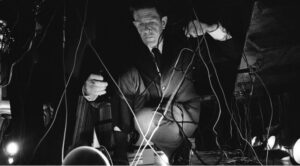Wotan's digital world comes alive on the Detroit Opera House stage thanks to LA-based PXT Studio and its founders Kaitlyn Pietras and Jason H. Thompson. If you attended our groundbreaking production of Twilight Gods, then you are already familiar with their work! For The Valkyries, PXT continues their Detroit collaboration with the help of three graduates of Detroit’s College for Creative Studies: Thomas Hamilton, Kayla Wenzel, and Eli McCaffrey. Together, the team uses an approach that pulls from both the future of virtual reality spaces like the Metaverse, as well as the theater magic that has brought new, imaginative worlds to the opera stage for centuries.
As PXT co-founder Jason H. Thompson explains,
“We began with a retro-futuristic vision that we co-created with director Yuval Sharon, merging a love of Hollywood movie making with a science-fiction aesthetic. We’ve been thinking about incorporating the power of real-time graphics and animations into our workflow and The Valkyries was the perfect candidate.

The foundation of the world was built in a virtual, three-dimensional space. The unique part of this process was that Yuval was able to go into the 3D environment with a Virtual Reality (VR) headset in order to setup virtual cameras as if he were a film director on location. These virtual cameras are animated to create cinematic shots and are linked to the live cameras in the performance space. When the in-person cameras pan or zoom, the virtual cameras mimic the live camera movement.
To capture the performers in the green screen environment, five Panasonic robotic cameras are programmed to have their presets recalled throughout the performance. Instead of a single perspective, these cameras can create composite images — combining several areas of the stage to place actors at different depths and locations in the 3D world.


All of the action is presented on a 40’ x 16’ stage with a 16’ tall green wall. Performers are blocked on a grid system sometimes with a very tight precision to create the illusion of impossible isolations like a Valkyrie singing on a cliff by herself on a stage full of performers.
Through a great deal of planning and animation work over the course of six months, we devised a video design that mirrored the liveness of the performances from the singers and allowed us to create a dynamic live film — recreated shot for shot every time we perform it.”

Kayla Wenzel:
“I always love seeing behind the scenes stuff and learning how things work. I'm very technical and creative, and I always feel torn in the middle between the two. At CCS I entered the entertainment arts program and brought those together in game development and working in 3D. I haven't worked on an opera or live action piece, so it was really interesting to see how things developed in real time. I was really excited at the chance to work with something that was incorporating extended reality. I wasn't really sure what to expect, honestly it was a little daunting, but exciting. When we first started going into it, I learned about the opera itself. It reminded me of Odysseus or Gilgamesh, like the older legends.
My specialty is environmental art. That’s a video game’s level design, or landscape elements, like the trees I made for The Valkyries. It's essentially world building – that's the part I love about it. I love creating a place where you can go and get sucked into the storytelling and history of the environment, informing what kind of world that you're in, through the environment.”
Thomas Hamilton:
“We're working in Unreal Engine, which is a video game engine, and then all the modeling I did was also in video game software. A lot of the techniques I used to create Valhalla and Wotan’s escalator came from game art. I had to model and animate the escalator in Autodesk Maya (a 3D animation and visual effects software), but then bringing it into Unreal and giving it the right look was something new to me. I had to figure out how to animate it into existence. CCS really prepares you for that. That was probably one of the biggest skills I learned at school: if you don't know how to do something, you're going to learn to research it and spend some hours learning, sometimes bashing your head against the wall. But you'll get it eventually.
[Before The Valkyries] but honestly I didn’t had much interest in opera. When I was first told about it, I was like, this is weird, but I think this can be really cool. It was definitely an eye-opening experience. I think it'll be the first opera I've ever been to!”

The Valkyries is a high-tech treatment of the most famous act in Wagner’s Ring Cycle makes this an experience you will not want to miss. Detroit Opera’s own Yuval Sharon and Christine Goerke join forces in this unique production which zooms in on the drama of Act III, beginning with the unforgettable “Ride of the Valkyries” and ending with “Magic Fire Music.”





